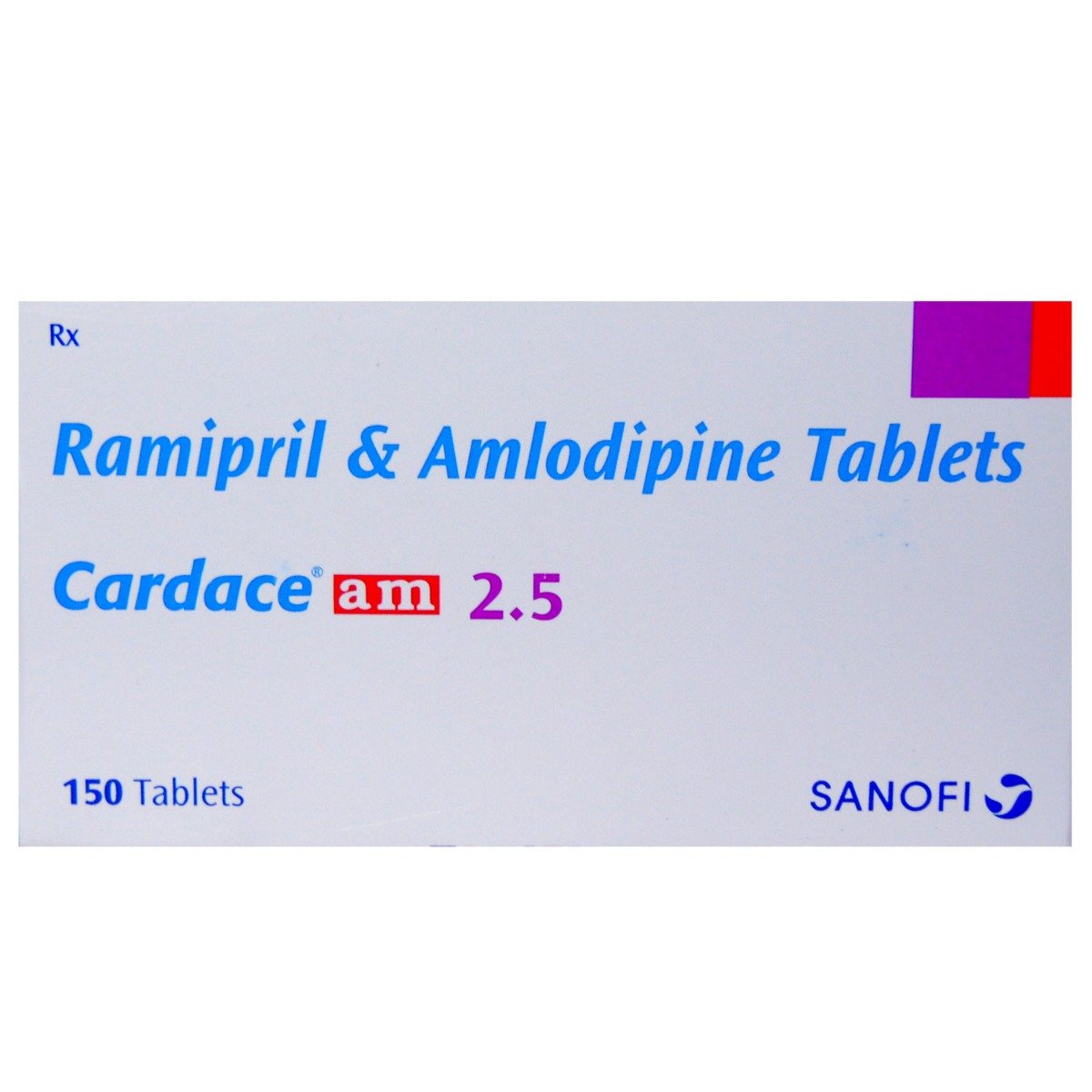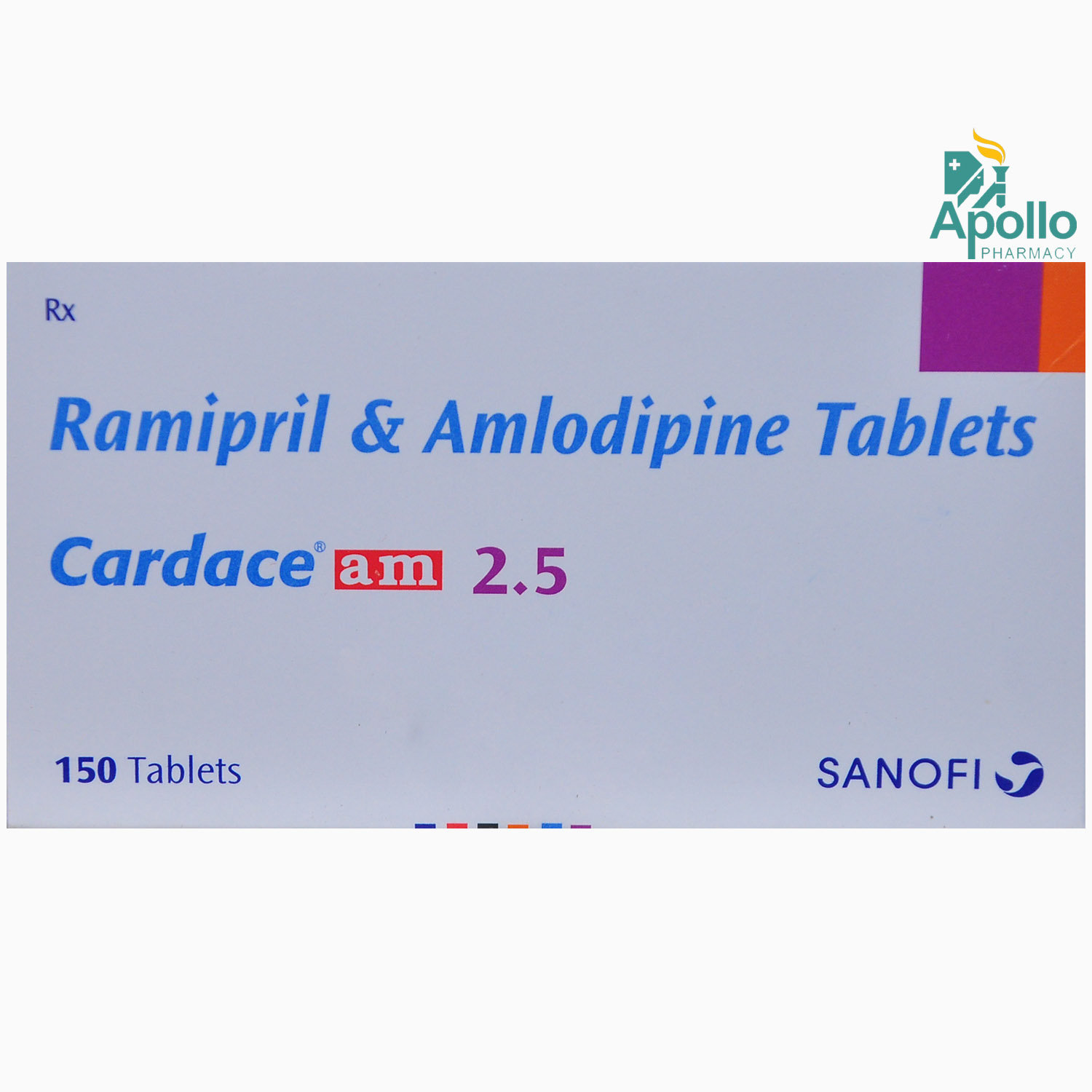Ramistar-AM 2.5 mg/5 mg Tablet
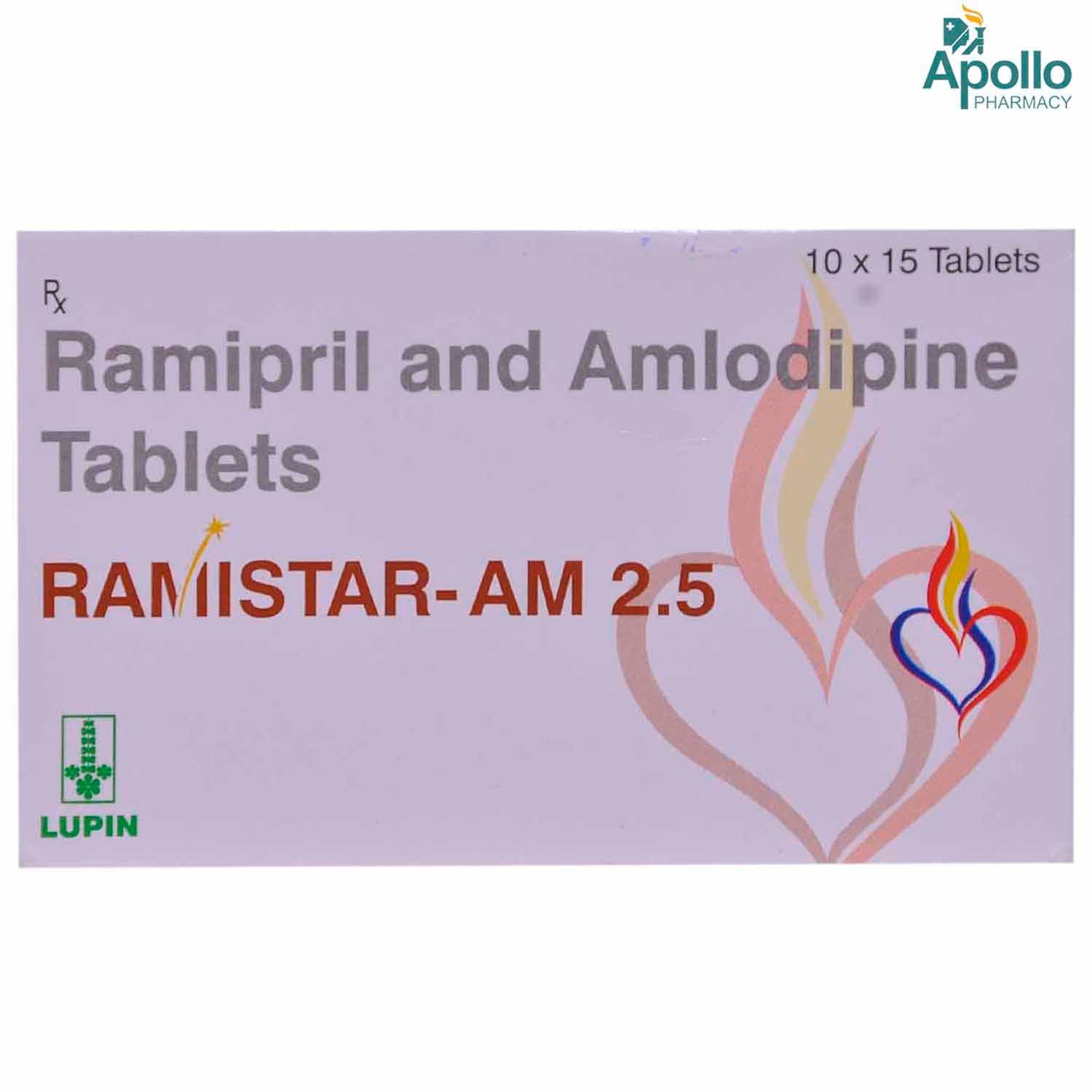
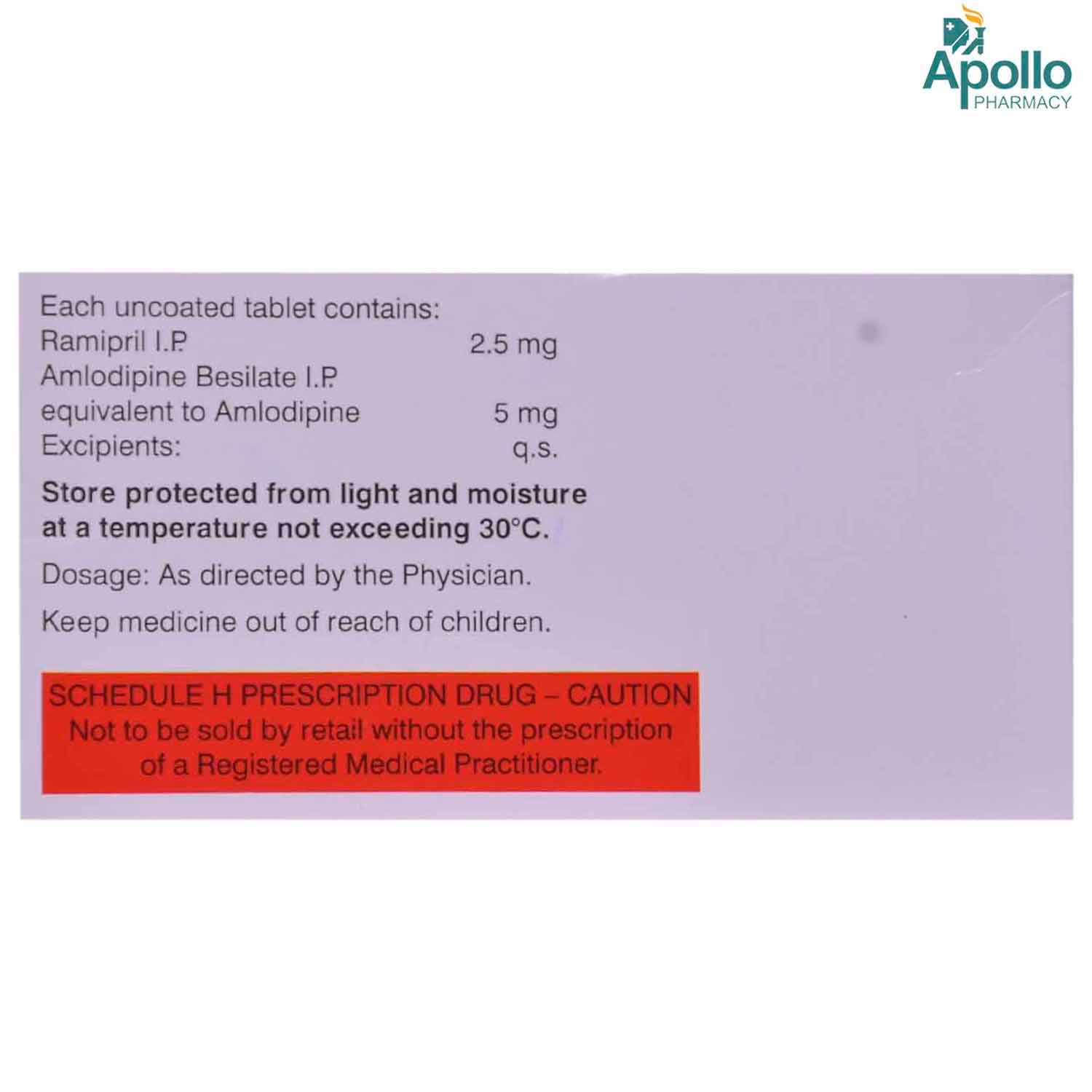
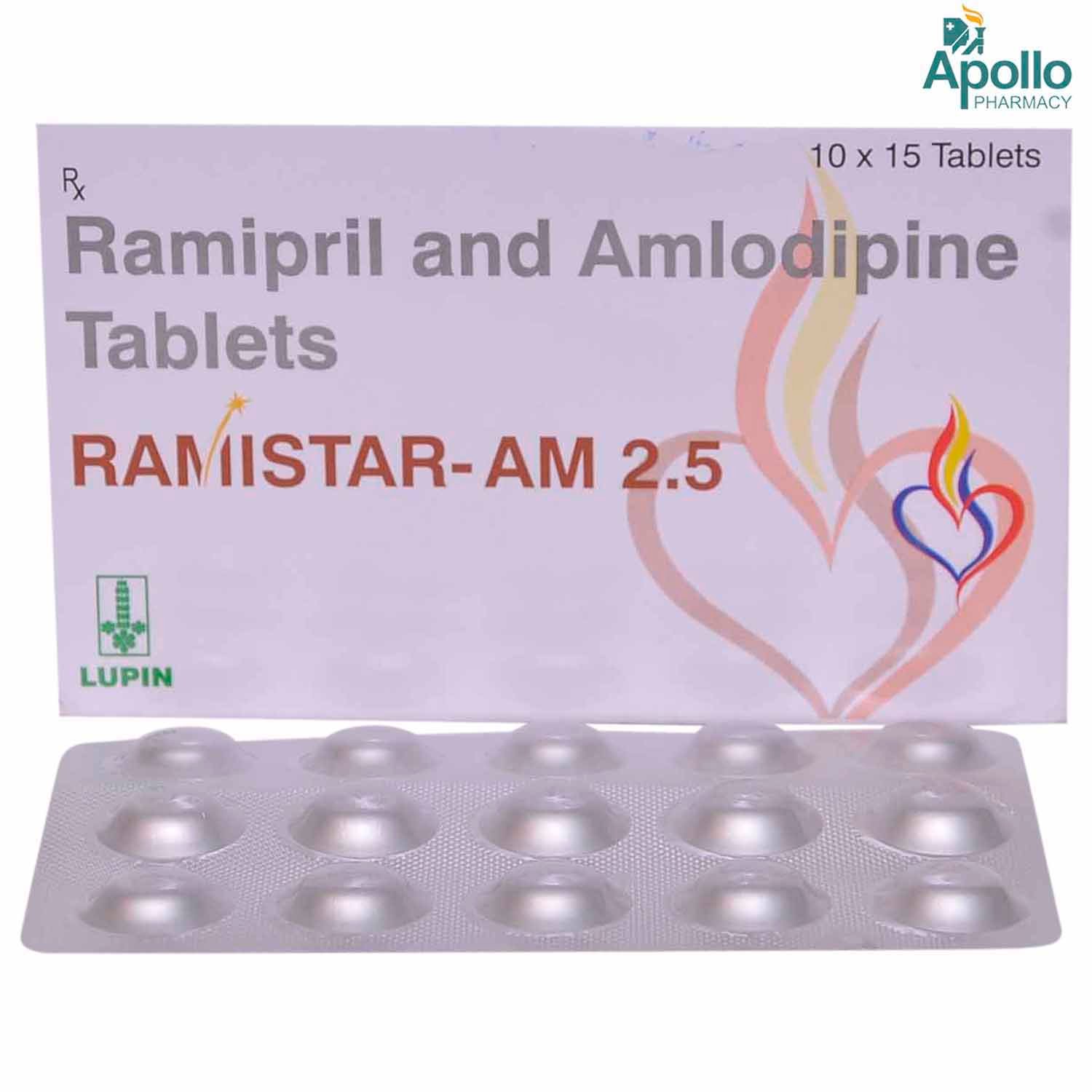
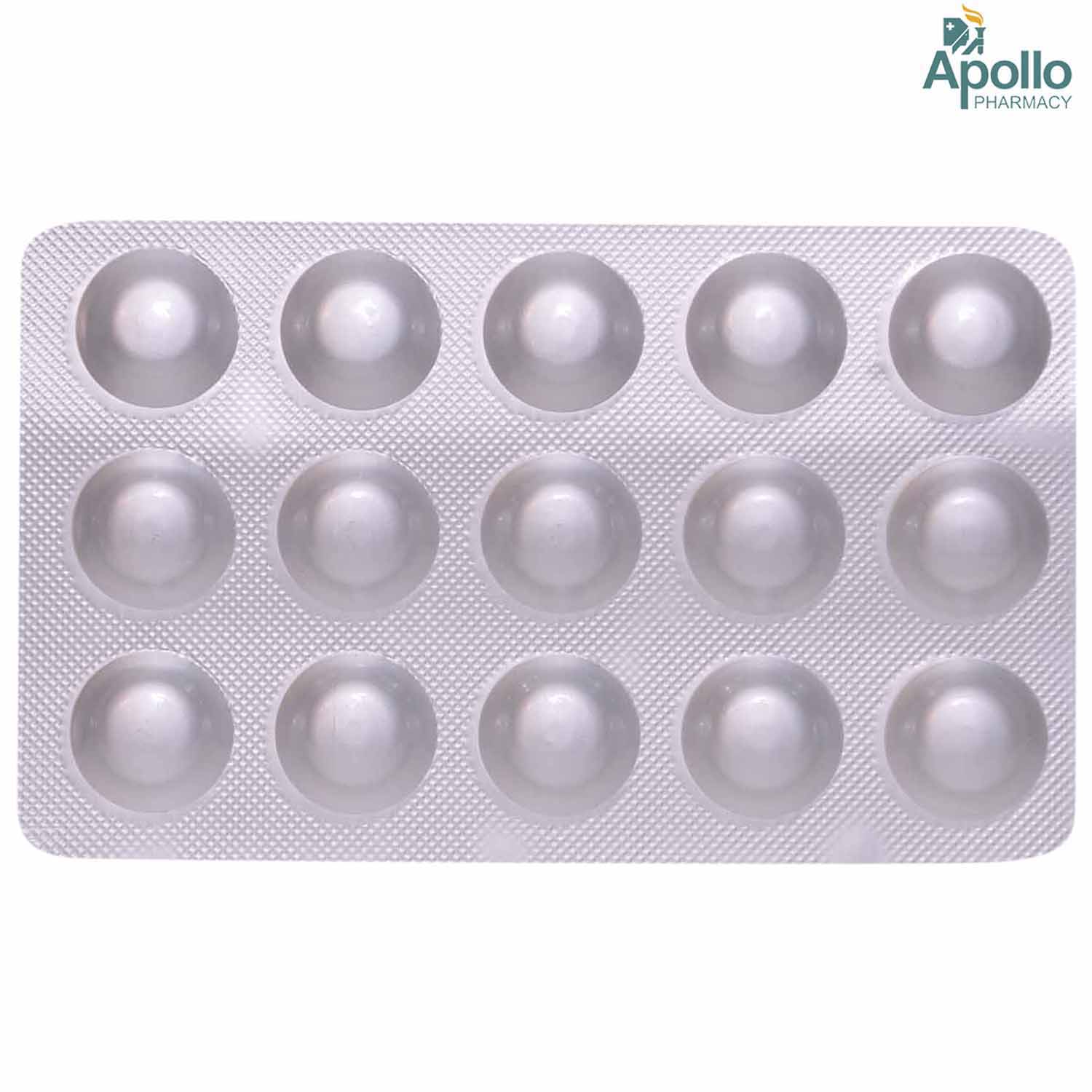
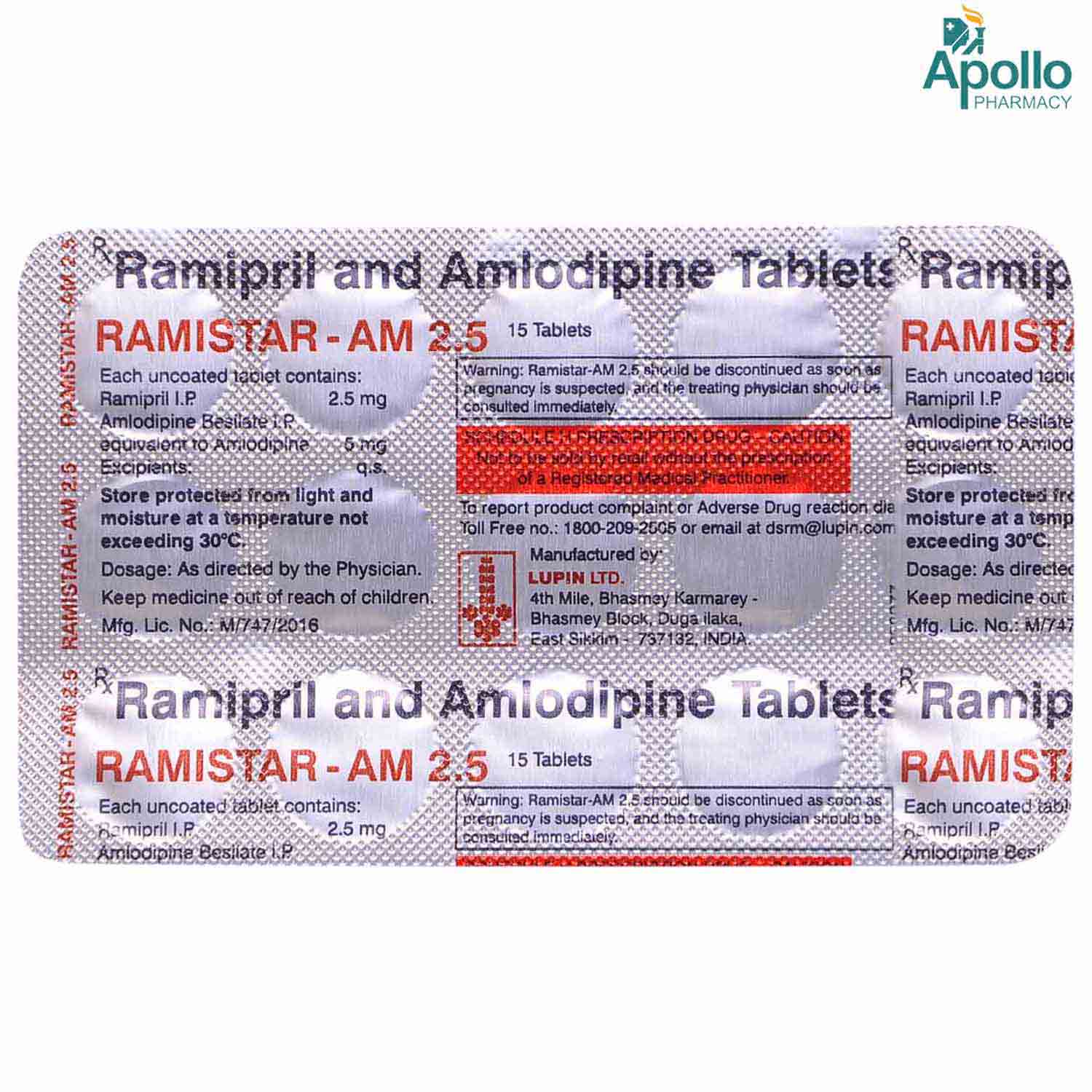
MRP ₹158.5
(Inclusive of all Taxes)
₹23.8 Cashback (15%)
know your delivery time
Provide Delivery Location
Composition :
Manufacturer/Marketer :
Consume Type :
Expires on or after :
Return Policy :

Secure Payment

Trusted by 8 Crore Indians

Genuine Products
Therapeutic Class
Country of origin
Manufacturer/Marketer address
Author Details
We provide you with authentic, trustworthy and relevant information
Disclaimer
Alcohol
Safe if prescribed
Alcohol may lower your blood pressure. It would help if you avoided or limit consuming alcohol.
Pregnancy
Consult your doctor
It is advised to seek medical advice before using Ramistar-AM 2.5 mg/5 mg Tablet if you plan to conceive or a pregnant before using Ramistar-AM 2.5 mg/5 mg Tablet .
Breast Feeding
Consult your doctor
There are limited studies on how Ramistar-AM 2.5 mg/5 mg Tablet affects breastfed infants. Please consult your doctor before using Ramistar-AM 2.5 mg/5 mg Tablet if you are a lactating mother.
Driving
Safe if prescribed
Ramistar-AM 2.5 mg/5 mg Tablet may cause side effects due to lowering of the blood pressure such as dizziness or tiredness. If you feel dizzy or tired when taking this medicine, do not drive or use any tools or machines.
Liver
Consult your doctor
Let your doctor know if you have any history of liver diseases before using Ramistar-AM 2.5 mg/5 mg Tablet . Ramistar-AM 2.5 mg/5 mg Tablet is to be administered with caution in patients with severe hepatic impairment.
Kidney
Consult your doctor
Let your doctor know if you have any history of kidney diseases before using Ramistar-AM 2.5 mg/5 mg Tablet . Ramistar-AM 2.5 mg/5 mg Tablet is primarily eliminated by the kidney and can be accumulated in patients with renal impairment.
Children
Safe if prescribed
Ramistar-AM 2.5 mg/5 mg Tablet is not recommended for use in children as the efficacy and safety has not been established.
Product Substitutes
About Ramistar-AM 2.5 mg/5 mg Tablet
Ramistar-AM 2.5 mg/5 mg Tablet belongs to the class of 'anti-hypertensive drugs', primarily used to treat hypertension (high blood pressure). Hypertension is a medical condition, in which the blood exerts high pressure (force exerted by circulating blood) against blood vessel's walls. This condition makes the heart to work harder in pumping the blood to the whole body. Hypertension can cause severe health complications, including stroke, heart failure, heart attack and kidney failure.
Ramistar-AM 2.5 mg/5 mg Tablet is a combination of Amlodipine (calcium channel blocker) and Ramipril (angiotensin-converting enzyme inhibitor). Amlodipine is used to treat high blood pressure, Prinzmetal's or variant angina (chest pain) and other conditions caused by coronary artery disease. It relaxes blood vessels, so that blood passes through them easily, thereby lowering the blood pressure. It also improves blood supply to the heart muscle to receive more oxygen and thus preventing chest pain. Ramipril relaxes and widens the blood vessels making it easier for the heart to pump blood throughout the body, thereby lowering blood pressure. It also decreases the body’s production of certain substances that raise blood pressure.
Your doctor will advise you how often you take Ramistar-AM 2.5 mg/5 mg Tablet based on your medical condition. In some cases, you may experience blurred vision, sweating, confusion, tiredness, stomach upset, flushing (sense of warmth in the face, ears, neck and trunk), dizziness, headache and swelling of the ankles or feet. Most of these side effects of Ramistar-AM 2.5 mg/5 mg Tablet do not require medical attention and gradually resolve over time. However, if the side effects are persistent, please reach out to your doctor.
Do not stop taking Ramistar-AM 2.5 mg/5 mg Tablet without consulting your doctor since it may worsen your condition and increase the risk of future heart problems. Regular monitoring of blood pressure, electrolyte levels and kidney functioning is advised while taking Ramistar-AM 2.5 mg/5 mg Tablet . Inform your doctor if you are suffering from kidney, liver or heart diseases. Please tell your doctor if you are taking any other medicines or have any allergic reactions to Ramistar-AM 2.5 mg/5 mg Tablet . Reducing the amount of table salt (sodium chloride) in your food often relieves the body's swelling. Let your doctor know if you use any prescription and non-prescription medications you are taking, including vitamins, before starting Ramistar-AM 2.5 mg/5 mg Tablet . If you are pregnant or breastfeeding, please tell your doctor so that the dosage of Ramistar-AM 2.5 mg/5 mg Tablet can be prescribed accordingly.
Uses of Ramistar-AM 2.5 mg/5 mg Tablet
Medicinal Benefits Mweb
Key Benefits
Ramistar-AM 2.5 mg/5 mg Tablet consists of Amlodipine (calcium channel blocker) and Ramipril (angiotensin-converting enzyme inhibitor). Amlodipine relaxes blood vessels so that blood passes through them easily, thereby lowering blood pressure. It also treats chest pain by improving the blood supply to the heart muscle to receive more oxygen. Amlodipine also improves a person's tolerance to exercise and keeps the blood pressure at acceptable levels. Ramipril relaxes and widens the blood vessels making it easier for the heart to pump blood throughout the body, thereby lowering blood pressure.
Directions for Use
Side Effects of Ramistar-AM 2.5 mg/5 mg Tablet
- Blurred vision
- Sweating
- Confusion
- Tiredness
- Stomach upset
- Flushing (sense of warmth in the face, ears, neck and trunk)
- Dizziness
- Headache
- Swelling of the ankles or feet
Drug Warnings
Do not use Ramistar-AM 2.5 mg/5 mg Tablet if you are allergic to Ramistar-AM 2.5 mg/5 mg Tablet or any of its components. Please inform your doctor if you are using any prescription and non-prescription medications you are taking, including vitamins, before starting Ramistar-AM 2.5 mg/5 mg Tablet . Let your doctor know if you have any history of severe heart, kidney or liver diseases, high potassium levels (hyperkalaemia), bone marrow suppression, and aortic stenosis (heart valve problem). Please consult your doctor if you plan to conceive, are pregnant, or are a breastfeeding mother before using Ramistar-AM 2.5 mg/5 mg Tablet . Ramistar-AM 2.5 mg/5 mg Tablet can increase the chances of light-headedness so rise slowly if you are sitting/lying and avoid operating any machine or doing any work that needs mental alertness.
Drug-Drug Interactions
Drug-Drug Interactions
Login/Sign Up
Using Ramistar-AM 2.5 mg/5 mg Tablet together with dantrolene may increase the risk of hyperkalemia (high blood potassium).
How to manage the interaction:
Taking Ramistar-AM 2.5 mg/5 mg Tablet with Dantrolene can cause an interaction, consult a doctor before taking it. You should seek medical attention if you experience nausea, vomiting, weakness, confusion, tingling of the hands and feet, a weak pulse, or a slow or irregular heartbeat. Do not stop using any medications without talking to a doctor.
Taking aliskiren together with Ramistar-AM 2.5 mg/5 mg Tablet may increase the risk of serious side effects such as kidney problems, low blood pressure, and high potassium levels in the blood. High levels of potassium can develop into a condition known as hyperkalemia, which in severe cases can lead to kidney problems, muscle paralysis and irregular heart rhythm.
How to manage the interaction:
Taking Ramistar-AM 2.5 mg/5 mg Tablet with Aliskiren is not recommended, but can be taken if prescribed by a doctor. However, consult your doctor if you feel nausea, vomiting, weakness, confusion, tingling in the hands and feet, a sensation of heaviness in the legs, a weak pulse, or a slow or irregular heartbeat. You must drink enough fluids while taking these medications. It is advised to reduce the intake of foods high in potassium, including tomatoes, raisins, figs, potatoes, lima beans, bananas, plantains, papayas, pears, cantaloupes, mangoes. Do not discontinue any medications without a doctor's advice.
Using Ramistar-AM 2.5 mg/5 mg Tablet and mitotane together may drastically lower Ramistar-AM 2.5 mg/5 mg Tablet blood levels, which makes the medicine less effective.
How to manage the interaction:
Although co-administration of Ramistar-AM 2.5 mg/5 mg Tablet with mitotane can result in an interaction, it can be taken if a doctor has advised it. Do not discontinue any medications without consulting a doctor.
Using phenobarbital and Ramistar-AM 2.5 mg/5 mg Tablet may drastically lower Ramistar-AM 2.5 mg/5 mg Tablet blood levels, which makes the medicine less effective.
How to manage the interaction:
Although co-administration of phenobarbital with Ramistar-AM 2.5 mg/5 mg Tablet can result in an interaction, it can be taken if a doctor has advised it. Do not discontinue any medications without consulting a doctor.
Coadministration of Ramistar-AM 2.5 mg/5 mg Tablet and carbamazepine together may significantly reduce Ramistar-AM 2.5 mg/5 mg Tablet blood levels, making the medicine less effective.
How to manage the interaction:
Although there is an interaction between Ramistar-AM 2.5 mg/5 mg Tablet with carbamazepine, it can be taken if a doctor has advised it. However, if you experience any unusual symptoms contact the doctor immediately. Do not stop using any medications without talking to a doctor.
Using Ramistar-AM 2.5 mg/5 mg Tablet and phenytoin together may drastically lower Ramistar-AM 2.5 mg/5 mg Tablet blood levels, which makes the medicine less effective.
How to manage the interaction:
Although Ramistar-AM 2.5 mg/5 mg Tablet with phenytoin can result in an interaction, it can be taken if a doctor has advised it. Do not discontinue any medications without consulting a doctor.
Using Ramistar-AM 2.5 mg/5 mg Tablet and primidone together may lower Ramistar-AM 2.5 mg/5 mg Tablet blood levels, which makes the medicine less effective.
How to manage the interaction:
Although co-administration of Ramistar-AM 2.5 mg/5 mg Tablet with primidone can result in an interaction, it can be taken if a doctor has advised it. Do not discontinue any medications without consulting a doctor.
Coadministration of lemborexant and Ramistar-AM 2.5 mg/5 mg Tablet may increase the blood levels of lemborexant.
How to manage the interaction:
Although co-administration of Ramistar-AM 2.5 mg/5 mg Tablet with Lemborexant can result in an interaction, it can be taken if a doctor has advised it. However, consult your doctor if you experience abnormal sleep patterns, worsening of depression, changes in heartbeat, or headache. Do not discontinue any medications without consulting a doctor.
Taking simvastatin with Ramistar-AM 2.5 mg/5 mg Tablet may result in considerably higher blood levels of simvastatin and may increase the risk of side effects (liver damage and rhabdomyolysis - an uncommon but serious illness characterized by the breakdown of skeletal muscle tissue).
How to manage the interaction:
Although taking Ramistar-AM 2.5 mg/5 mg Tablet with simvastatin can result in an interaction, it can be taken if a doctor has advised it. If you have unexplained muscular pain, soreness, or weakness while using simvastatin, especially if these symptoms are accompanied by fever or dark-colored urine, consult the doctor immediately. However, if you develop a fever, chills, joint pain or swelling, unusual bleeding or bruising, skin rash, itching, loss of appetite, fatigue, nausea, vomiting, dark colored urine, and/or yellowing of the skin or eyes, consult the doctor. Do not stop using any medications without a doctor's advice.
Co-administration of Ramistar-AM 2.5 mg/5 mg Tablet can make Sirolimus may increase the risk of angioedema (a condition associated with swelling of the face, eyes, lips, tongue, throat, and occasionally also the hands and feet).
How to manage the interaction:
There may be a possibility of interaction between Ramistar-AM 2.5 mg/5 mg Tablet and Sirolimus, but it can be taken if prescribed by a doctor. However, consult the doctor if you notice any swelling of the face, eyes, lips, tongue, throat, hands and feet or have trouble breathing or swallowing. Do not stop using any medications without a doctor's advice.
Drug-Food Interactions
Drug-Food Interactions
Login/Sign Up
Lentils, Orange Juice, Oranges, Raisins, Potatoes, Salmon Dried, Spinach, Sweet Potatoes, Tomatoes, Coconut Water, Beans, Beetroot, Broccoli, Bananas, Apricots, Avocado, Yogurt
How to manage the interaction:
Taking Ramistar-AM 2.5 mg/5 mg Tablet with potassium-containing salt substitutes or potassium supplements can cause high levels of potassium in the blood. Avoid taking potassium-containing salt substitutes or potassium supplements while being treated with Ramistar-AM 2.5 mg/5 mg Tablet.
Drug-Diseases Interactions
Drug-Diseases Interactions
Login/Sign Up
Drug-Drug Interactions Checker List
- SIMVASTATIN
- PREDNISOLONE
- IBUPROFEN
- NAPROXEN
- RAMIPRIL
- METOPROLOL
- BENDROFLUMETHIAZIDE
- SILDENAFIL
- ALLOPURINOL
- INSULIN GLARGINE
- METFORMIN
- SITAGLIPTIN
- FUROSEMIDE
- PREGABALIN
Habit Forming
Special Advise
- Monitor your blood pressure regularly and seek medical advice if you notice any drastic fluctuations.
- Ramistar-AM 2.5 mg/5 mg Tablet may affect patients with hepatic impairment, and hence it is used cautiously, and Liver function monitoring and Liver Function Tests are advised to monitor the liver enzyme changes.
- Your doctor may advise you to get a regular kidney function test, blood examinations for potassium levels and other electrolytes while using Ramistar-AM 2.5 mg/5 mg Tablet to rule out any renal impairment.
Diet & Lifestyle Advise
- Keep your weight under control with body mass index (BMI) between 19.5 and 24.9.
- Do regular physical activity or exercise for at least 150 minutes per week or about 30 minutes most days of the week. Doing this can help you to lower your raised blood pressure by about 5 mm of Hg.
- Limit sodium chloride intake (table salt) in your daily diet to 2300 mg per day or less than 1500 mg is ideal for most adults.
- If you are taking alcohol, use only one serving for women and two servings for men.
- Quit smoking to lower the risk of heart diseases.
- Avoid chronic stress as it can raise your blood pressure. Try to enjoy and spent time with your loved ones to cope with stress.
- Monitor your blood pressure daily, and if you notice any fluctuations frequently, please contact your doctor immediately.
- Try including heart-healthy omega 3 fatty acid-containing foods in your daily diet. You can also use low-fat cooking oils like olive oil, soybean oil, canola oil and coconut oil to lower your elevated blood pressure.
All Substitutes & Brand Comparisons
RX
Out of StockHopecard AM Tablet 10's
Aristo Pharmaceuticals Pvt Ltd
₹37.9
(₹3.41 per unit)
64% CHEAPERRX
Out of StockRIMARK-AM 5MG/2.5MG TABLET
Lanark Laboratories Pvt Ltd
₹48
(₹4.32 per unit)
54% CHEAPERRX
Out of StockRAMZE-AM 5MG/2.5MG TABLET
₹72
(₹4.32 per unit)
54% CHEAPER

Have a query?
Buy best Cardiology products by
Torrent Pharmaceuticals Ltd
Sun Pharmaceutical Industries Ltd
Lupin Ltd
Intas Pharmaceuticals Ltd
Cipla Ltd
Micro Labs Ltd
Macleods Pharmaceuticals Ltd
Abbott India Ltd
Ajanta Pharma Ltd
Ipca Laboratories Ltd
Eris Life Sciences Ltd
Mankind Pharma Pvt Ltd
Lloyd Healthcare Pvt Ltd
Dr Reddy's Laboratories Ltd
Glenmark Pharmaceuticals Ltd
Emcure Pharmaceuticals Ltd
Alembic Pharmaceuticals Ltd
Alkem Laboratories Ltd
East West Pharma India Pvt Ltd
USV Pvt Ltd
Zydus Healthcare Ltd
Aristo Pharmaceuticals Pvt Ltd
Elbrit Life Sciences Pvt Ltd
J B Chemicals & Pharmaceuticals Ltd
Zydus Cadila
Akumentis Healthcare Ltd
Alteus Biogenics Pvt Ltd
Hbc Life Sciences Pvt Ltd
Fusion Health Care Pvt Ltd
Troikaa Pharmaceuticals Ltd
La Renon Healthcare Pvt Ltd
Corona Remedies Pvt Ltd
Jubilant Lifesciences Ltd
Medley Pharmaceuticals Ltd
Knoll Healthcare Pvt Ltd
Msn Laboratories Pvt Ltd
Zuventus Healthcare Ltd
Cadila Pharmaceuticals Ltd
Blue Cross Laboratories Pvt Ltd
Lividus Pharmaceuticals Pvt Ltd
Morepen Laboratories Ltd
Ranmarc Labs
Shrrishti Health Care Products Pvt Ltd
Sanofi India Ltd
Steris Healthcare
Elder Pharmaceuticals Ltd
Primus Remedies Pvt Ltd
Unison Pharmaceuticals Pvt Ltd
Eswar Therapeutics Pvt Ltd
Knoll Pharmaceuticals Ltd
Tas Med India Pvt Ltd
Systopic Laboratories Pvt Ltd
Indiabulls Pharmaceuticals Pvt Ltd
Leeford Healthcare Ltd
Sinsan Pharmaceuticals Pvt Ltd
Biochem Pharmaceutical Industries Ltd
Cadila Healthcare Ltd
Azkka Pharmaceuticals Pvt Ltd
Nirvana India Pvt Ltd
Orsim Pharma
Prevego Healthcare & Research Pvt Ltd
Econ Healthcare
Elinor Pharmaceuticals (P) Ltd
FDC Ltd
Sunij Pharma Pvt Ltd
Nicholas Piramal India Ltd
Astra Zeneca Pharma India Ltd
Pfizer Ltd
Lia Life Sciences Pvt Ltd
Shine Pharmaceuticals Ltd
Elicad Pharmaceuticals Pvt Ltd
Indoco Remedies Ltd
Proqol Health Care Pvt Ltd
Vasu Organics Pvt Ltd
Biocon Ltd
Opsis Care Lifesciences Pvt Ltd
Johnlee Pharmaceuticals Pvt Ltd
Merck Ltd
Wockhardt Ltd
Auspharma Pvt Ltd
Ergos Life Sciences Pvt Ltd
Lakshya Life Sciences Pvt Ltd
Ordain Health Care Global Pvt Ltd
Pficus De Med Pvt Ltd
ALICAN PHARMACEUTICAL PVT LTD
RPG Life Sciences Ltd
Glynis Pharmaceuticals Pvt Ltd
Orris Pharmaceuticals
Samarth Life Sciences Pvt Ltd
Aprica Pharmaceuticals Pvt Ltd
Aretaeus Pharmaceuticals Pvt Ltd
Koye Pharmaceuticals Pvt Ltd
Neocardiab Care
Retra Life Science Pvt Ltd
Alniche Life Sciences Pvt Ltd
Alvio Pharmaceuticals Pvt Ltd
Arkas Pharma Pvt Ltd
Atos Lifesciences Pvt Ltd
Divine Savior Pvt Ltd
Metalis Lifesciences Pvt Ltd
Customers Also Bought
Recommended for a 30-day course: 2 Strips





